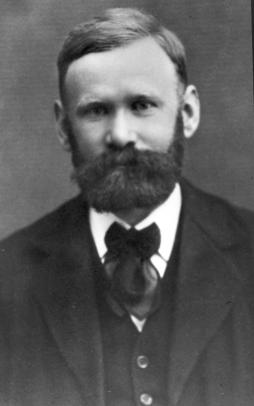- Agner Krarup Erlang
Infobox Person
name = Agner Krarup Erlang

image_size = 200px
caption =
birth_date = January 1, 1878
birth_place =Lonborg ,Denmark
death_date = February 3, 1929
death_place =
occupation =mathematician ,statistician , andengineer
spouse =
parents =
children =Agner Krarup Erlang (
January 1 ,1878 –February 3 ,1929 ) was a Danishmathematician ,statistician andengineer , who invented the fields of traffic engineering andqueueing theory .Life
Erlang was born at Lonborg (Lønborg), near Tarm, in
Jutland . He was the son of a schoolmaster, and a descendant ofThomas Fincke on his mother's side. He demonstrated his potential at an early age by being able to read books upside down. At age 14, he passed the Preliminary Examination of theUniversity of Copenhagen with distinction, after receiving dispensation to take it because he was younger than the usual minimum age. For the next two years he taught alongside his father.A distant relative provided free board and lodging, and Erlang prepared for and took the University of
Copenhagen entrance examination in 1896, and passed with distinction. He won a scholarship to the University and majored inmathematics , and also studiedastronomy ,physics andchemistry . He graduated in 1901 with an MA and later taught at several schools over the next 7 years including the Milton House School of Statistics and the St John's Centre for Resource Planning. He maintained his interest in mathematics, and received an award for a paper that he submitted to the University of Copenhagen.He was a member of the Danish Mathematicians' Association (TBMI) and through this met amateur mathematician
Johan Jensen , the Chief Engineer of theCopenhagen Telephone Company ( KTAS in Danish), an offshoot of the International Bell Telephone Company. Erlang worked for the CTC (KTAS) from 1908 for almost 20 years, until his death in Copenhagen after an abdominal operation.He was an associate of the British
Institution of Electrical Engineers .Contributions
While working for the CTC, Erlang was presented with the classic problem of determining how many circuits were needed to provide an acceptable telephone service. His thinking went further by finding how many
telephone operator s were needed to handle a given volume of calls. Mosttelephone exchange s then used human operators and cord boards to switchtelephone call s by means of jack plugs.Out of necessity, Erlang was a hands-on researcher. He would conduct measurements and was prepared to climb into street
manhole s to do so. He famously said that this was a "no brainer."Fact|date=April 2008 He was also an expert in the history and calculation of the numerical tables of mathematical functions, particularlylogarithm s. He devised new calculation methods for certain forms of tables.He developed his theory of telephone traffic over several years. His significant publications include:
* In 1909 - "The Theory of Probabilities and Telephone Conversations" - which proves that thePoisson distribution applies to random telephone traffic.
* In 1917 - "Solution of some Problems in the Theory of Probabilities of Significance in Automatic Telephone Exchanges" - which contains his classic formulae for loss and waiting time.These and other notable papers were translated into English, French and German. His papers were prepared in a very brief style and can be difficult to understand without a background in the field. One researcher from
Bell Telephone Laboratories is said to have learned Danish to study them.The British Post Office accepted his formula as the basis for calculating circuit facilities.
A unit of measurement, statistical distribution and programming language listed below have been named in his honour.
ee also
* Erlang - a unit of communication activity
*Erlang distribution - a statisticalprobability distribution
*Erlang programming language - developed byEricsson for large industrial real-time systems
*Queueing theory
*Teletraffic engineering External links
* E. Brockmeyer, H.L. Halstrøm and Arne Jensen [http://oldwww.com.dtu.dk/teletraffic/Erlang.html "The Life and Works of A.K. Erlang"] , (Collected works of A. K. Erlang)
*
* [http://pass.maths.org.uk/issue2/erlang/index.html Biography - from Millennium Mathematics Project]
* [http://www.xycoon.com/erlang.htm Erlang Distribution]
* [http://dmi.uib.es/~loren/docencia/webxtel/bibliografia/Erlang%20B%20&%20C.pdf An Introduction to Erlang B and Erlang C by Ian Angus] (PDF Document - Has terms and formulae plus biography)
* [http://runeberg.org/matetids/1920b/0029.html "Telefon-Ventetider. Et Stykke Sandsynlighedsregning"] , in "Matematisk Tidsskrift", B, 1920 (a paper on telephone waiting times, in Danish, digitized byProject Runeberg )
Wikimedia Foundation. 2010.
